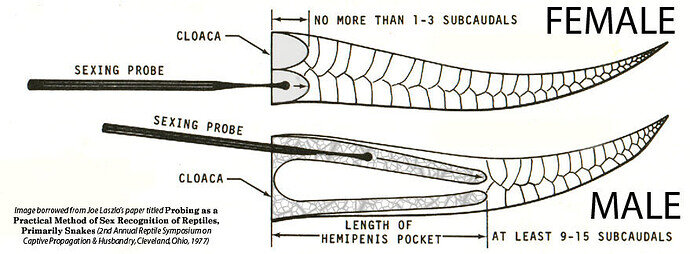I am in the midst of trying to learn to sex our ball pythons. I’ve watched multiple tutorials on both popping and probing by very experienced breeders (Justin at Kinova, Billy at Mutation Creation, etc.), and I’ve seen a couple of snakes popped in person. I’ve only just recently started attempting, VERY carefully, to pop myself. I’ve not quite got the popping down yet, and I have a feeling it could take me quite a while to get the coordination and movement of it just right. So, a couple of months ago, we bought a nice probe kit and I rewatched some tutorials and gave that a go.
But one thing is a little unclear to me. Which scales are we counting when we’re measuring probe depth? The videos I watched talked about the probe going in only two or three scale widths deep on a female, and around six deep on a male. But the scales along the bottom of the tail are not in even rows right at the vent - it’s like a random cluster of teeny tiny scales, and then past that, there are roughly equally sized scales in straight rows.
When someone says the probe goes in two scale widths deep, are they talking about the cluster of teeny scales, or the bigger scales beyond that? Are we measuring from the vent, or are we skipping the random cluster and measuring the probe against the more even, wider scales?
Also, on a similar note - when I was trying this out, I first checked several known males and known females, and despite not knowing exactly how the pros are measuring against the snakes’ scales, I could definitely see the difference in how deep the probe went on the males vs the females. When I felt I was getting a handle on the process, I went to check the snakes I REALLY wanted to check - a pair of twins whose popping by their breeder (and subsequently by one other breeder as well) left us a little uncertain as to their gender (they have either smaller than typical hemipenes or redder than typical lack-of-hemipenes). On both of them, the probe certainly didn’t go nearly as far as it did on our known males, but it also seemed to go a little farther than it did on our known females. Around four scale widths (if I was measuring correctly), aka basically right in between male depth and female depth.
What do people do when this happens? For these two specifically, I will probably end up doing a shed test, just to be certain. But, I’m assuming this might happen again, as it seems unlikely that I would have come across an extremely rare circumstance in our very small collection. So I would love to know what to do when you get a sort of in between result from a sexing. Do you assume male because the probe went in slightly farther than on a typical female? Or are some females just a little deeper? Did I maybe just not have the probe positioned correctly? I tried probing these two snakes several (but not too many) times to try to make sure I wasn’t just in the wrong spot, but I kept getting the same results with every attempt.
Please help me if you can! We originally thought these twins were probably either one male and one female or both females… then we graduated to thinking they were both males… and now we’ve moved on to just being completely confused. Hahaha. I would love to not only figure out what these twins are, but also learn more about sexing in general so that in the future when we hatch our own clutches, we will be able to determine the babies’ genders accurately. So any help here would be greatly appreciated!
